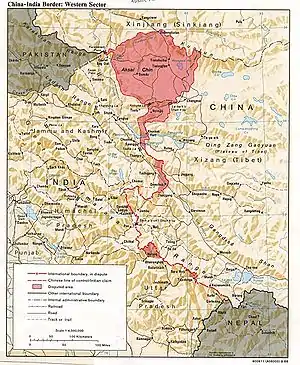Daulat Beg Oldi
Daulat Beg Oldi (also Oldie, DBO) is a historic campsite and current military base located in Ladakh, India on an ancient trade route connecting Ladakh to the Tarim Basin. It is named after Sultan Said Khan (Daulat Beg), who died here on his return journey after the invasion of Ladakh and Kashmir. The Chip Chap River flows just to the south of Daulat Beg Oldi from east to west. Daulat Beg Oldi also has one of the world's highest airstrips which is one of India's Advance Landing Ground (ALG), at an altitude of 5,065 meters (16,614 feet).
Daulat Beg Oldi | |
|---|---|
Military Base | |
 Indian Air Force Antonov An-32 taking off from Daulat Beg Oldi ALG | |
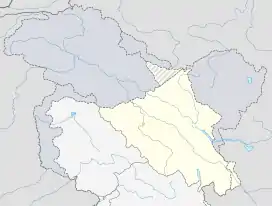 Daulat Beg Oldi Location in Ladakh, India  Daulat Beg Oldi Daulat Beg Oldi (India) | |
| Coordinates: 35.390°N 77.925°E | |
| Country | |
| Union Territory | Ladakh |
| District | Leh |
| Elevation | 5,100 m (16,700 ft) |
| Time zone | UTC+5:30 (IST) |
DBO is connected by 235 km long Darbuk-Shyok-DBO Road to Leh. It is primarily for use by the Indian Military, and off limits to civilians from Shyok onwards.[1]
Location and physical conditions
Daulat Beg Oldi lies near the easternmost point of the Karakoram Range in a cold desert region in the far north of India, just 8 km south of the Chinese border and 9 km northwest of the Aksai Chin Line of Actual Control between China and India. Other than Siachen Glacier military bases, it is India's northernmost settlement. The nearest civilian town is Murgo to the south, which has a small population of Baltis.[2]
The Indian government first announced plans in 2001 to construct a motorable road from Leh to its destination at Daulat Beg Oldi. The road was completed in 2019. The 255-km is Darbuk-Shyok-DBO Road runs at elevations between 4,000–5,000 metres (13,000–16,000 ft). The travel time is said to be six hours.[3]
The temperature plummets as low as -55 C in the winters. The weather deteriorates frequently with strong icy winds lashing much of DBO. DBO has very little if any vegetation or wildlife. Communication is possible only through INMARSAT (satellite) phones.
History
Expedition of Said Khan (Etymology)
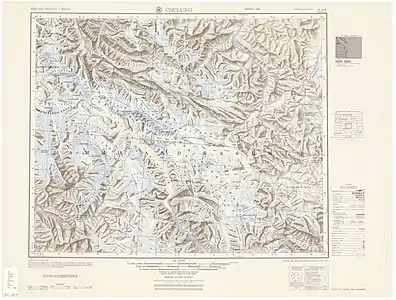
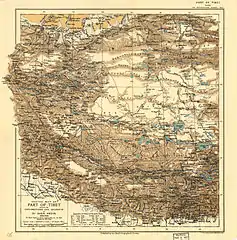
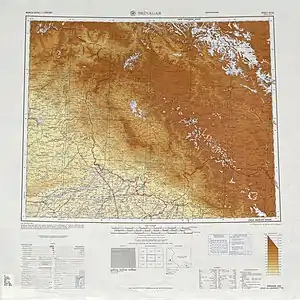
Daulat Beg Oldi literally means "spot where the great and rich man died"[4] in Turki.[5] There are various folklore about whom this refers to—such as the tale about this place being the location where a large caravan was destroyed,[6] or the tale about this place being the burial site of a rich man and his treasure.[7]
According to British colonial-era surgeon Henry Walter Bellew,[8][9] Daulat Baig Oldi means "the lord of the state died here" and the lord refers to early 16th century Sultan Said Khan of the Yarkent Khanate.[8] Said Khan purportedly died at this place while returning to Yarkent from a campaign in Ladakh.[10][11][12] He is sometime mentioned with title of Ghaza for his military expeditions.[12]
The account of this military expedition was recorded by his general Mirza Muhammad Haidar Dughlat, who was the Sultan's first cousin, in the work of history Tarikh-i-Rashidi (تاریخ رشیدی) (History of Rashid).[9]
In Autumn of 1531 (Safar 938 AH), the Sultan Said Khan left Yarkand with Haidar and a few thousand men. Upon first time crossing the Karakorum, the Sultan encountered severe altitude sickness, but he managed to recover. In the course of a few months of campaigning, they were able to devastate Nubra Valley. As winter approached, they split forces. The Sultan left for Baltistan; Haidar left for Kashmir. In Baltistan, the Sultan encountered a population of friendly Muslims, but he turned on them killing and enslaving them, possibly because they were Shiites which was heretic to orthodox Yarkandi Sunnis. On the way to Kashmir, Haider defeated the Dras near Zoji La. In Kashmir, he and his troops were hosted by the king of Srinagar. In the spring, the two parties met up again in Maryul, the Sultan decided to return to Yarkand, but he instructed Haider to conquer Tibet for Islam before his departure.[8][13]
On his way back to Yarkand in Summer of 1533 (end of 939 AH), the Sultan once again suffered severe altitude sickness. This time he succumbed to his illness near Karakoram Pass. Bellew argues that the location of his death was here at Daulat Beg Oldi. The news of Sultan's death led to a bloody succession which saw the ascension of Abdurashid Khan. Abdurashid Khan recalled the forces in Tibet and exiled Haidar. By then, Haidar had some successes against the Changpa Tibetans of Baryang, but his forces suffered greatly from the altitude and elements. By the time the army returned to Yarkand, of the starting few thousands, less than a dozen were left. The exiled Haidar received the refuge from his maternal aunt in Badakhshan. He eventually joined the ranks of the Mughal Empire where he wrote the Tarikh-i-Rashidi.[8][13] [14]
Modern era
The trade route via the Karakoram Pass was used by caravans traveling between Leh and the Tarim Basin. DBO is believed to have been a stopping point for the caravans but not known to have any permanent civilian population. India and China sealed their borders after the 1962 India-China War, ending most of the cross-border trade.
In April 2013, a platoon-sized contingent of the People's Liberation Army established a campsite 30 km southeast of DBO,[15] a location in the Indian military's "DBO sector." In reference to their own perception of the LAC's location, India initially claimed that the Chinese camp was 10 km on their side, later revising this to a 19 km claim,[16] and claimed that Chinese military helicopters had violated Indian airspace during the incident.[17] In early May, both sides withdrew their units further back.
Advanced Landing Ground
Daulat Beg Oldi Advanced Landing Ground  | |
|---|---|
| Summary | |
| Airport type | Military |
| Operator | Indian Airforce |
| Location | Ladakh, India |
| Elevation AMSL | 16,730 ft / 5,099 m |
The Indian Army maintains helipads and a gravel airstrip here, the highest airstrip in the world. Routine sorties are carried out using An-32 aircraft to provide relief and supplies to the troops stationed nearby.[18] The base was established during the Sino-Indian conflict in 1962, with the first landing by Squadron Leader C.K.S Raje who set a record for the world's highest aircraft landing at the time. It was operated with American-supplied Fairchild Packets from 1962 to 1966, when it had to be closed down suddenly when an earthquake caused loosening of the surface soil, making the area unsuitable for fixed-wing aircraft.[19] Work was undertaken to make the airfield operational again, and was marked on 31 May 2008, when an Indian Air Force An-32 landed.[20]
The Indian Air Force first landed transports here between 1962 and 1965 and then after a gap for 43 years, the IAF started landing at DBO in 2008. In a significant demonstration of its capabilities, the Indian Air Force landed a C-130J Super Hercules transport aircraft in Daulat Beg Oldie on 20 August 2013, thirty kilometers from where the 2013 Daulat Beg Oldi Incident took place in April 2013. This landing could qualify as a world record for a medium-lift aircraft landing at this altitude.[21][22][23]
India-China Border Meeting point
Daulat Beg Oldi – Tianwendian is the highest of the five officially agreed Border Personnel Meeting points between the Indian Army and the People's Liberation Army of China for regular consultations and interactions between the two armies, which helps in defusing stand-offs.[24] The first meeting at this location was held on August 1, 2015 (PLA Day). The events included a Chinese cultural program and other ceremonies meant to improve relations. Later in the month, India hosted a delegation from the PLA on the occasion of Indian Independence Day and celebrated with traditional songs and dances from Indian culture, Gatka martial arts, and motorcycle acrobatics performed by the Indian Army Corps of Signals.[25] The first ceremonial BPM ever held on New Year's Day was here in 2016.[24]
A meeting hut was constructed approximately a year after the meeting point was opened.[26]
See also
- Military bases
- List of ALGs
- List of Indian Air Force stations
- India-China military deployment on LAC
- List of disputed India-China areas
- Siachen Base Camp (India)
- Tianwendian
- Borders
- Actual Ground Position Line (AGPL)
- India–Pakistan International Border (IB)
- Line of Control (LoC)
- Line of Actual Control (LAC)
- Sir Creek (SC)
- Borders of China
- Borders of India
- Conflicts
- Kashmir conflict
- Siachen conflict
- Sino-Indian conflict
- List of disputed territories of China
- List of disputed territories of India
- List of disputed territories of Pakistan
- Depsang Plains
- Northern Areas
- Siachen Glacier
- Trans-Karakoram Tract
- Operations
- Operation Meghdoot, by India
- Operation Rajiv, by India
- Operation Safed Sagar, by India
- Other related topics
- India-China Border Roads
- List of extreme points of India
- Sino-Pakistan Agreement for transfer of Trans-Karakoram Tract to China
- Defence Institute of High Altitude Research
- Indian Astronomical Observatory
Notes
- From map: "THE DELINEATION OF INTERNATIONAL BOUNDARIES ON THIS MAP MUST NOT BE CONSIDERED AUTHORITATIVE"
- From map: "THE DELINEATION OF INTERNATIONAL BOUNDARIES MUST NOT BE CONSIDERED AUTHORITATIVE"
References
- India completes vital Ladakh road, The Tribune, 23 April 2019.
- PTI (19 April 2013). "Chinese troops intrude into Indian territory in Ladakh, erect a tented post". The Economic Times. Retrieved 2 January 2020.
The nearest inhabited town is Murgo to the south, which has a small population of Baltis who primarily depend on apricot farming and yak rearing.
- "India completes vital Ladakh road".
- Swami, Praveen (23 April 2013). "Ladakh incursion: India, China face-off at the 'gate of hell'". Firstpost. Retrieved 2 January 2020.
Daulat Beg Oldi, the spot where the great and rich man died
- Trotter, H. (1878). "On the Geographical Results of the Mission to Kashghar, under Sir T. Douglas Forsyth in 1873-74". Journal of the Royal Geographical Society of London. 48: 177. doi:10.2307/1798763. ISSN 0266-6235. JSTOR 1798763.
Daulat Beguldi (Turki for "Daulat Beg died", an appropriate name for so desolate a spot)
- Teg Bahadur Kapur (1987). Ladakh, the Wonderland: A Geographical, Historical, and Sociological Study. Mittal Publications. p. 28. ISBN 978-81-7099-011-6.
Daulat Beg and his large caravan was entirely destroyed about eighteen miles from the Karakoram pass on the Indian side.
- Kapadia, Harish (2005). Into the Untravelled Himalaya: Travels, Treks, and Climbs. Indus Publishing. p. 186. ISBN 978-81-7387-181-8.
It was believed that the rich man, Daulat Beg was buried here with his treasure.
- Kohli, Harish (2000). Across the Frozen Himalaya: The Epic Winter Ski Traverse from the Karakoram to Lipu Lekh. Indus Publishing. pp. 66–67. ISBN 978-81-7387-106-1.
According to H.W. Bellew, he was no ordinary traveller but a great warrior, a partisan of Babur, the conqueror of Ferghana and the king of Yarkand and Kashgar.
- Bellew, Henry Walter (1875). The history of Káshgharia. Calcutta: Foreign Department Press. pp. 66–67.
(p66) Daulat Beg Uild ... "The lord of the State died" ... (p67) Hydar ... wrote the Tarikhi Rashidi from which these details are derived
- Albert von Le Coq (14 December 2018). Buried Treasures of Chinese Turkestan: An Account of the Activities and Adventures of the Second and Third German Turfan Expeditions. Taylor & Francis. p. 292. ISBN 978-0-429-87141-2.
Daulat Bak Oldi (the royal prince died here), close to the Karakorum pass, is so called because the Sultan Said Khan of Kashgar, on his return from a successful campaign against West Tibet, died here from mountain sickness (Plate 50)
- Howard, Neil; Howard, Kath (2014), "Historic Ruins in the Gya Valley, Eastern Ladakh, and a Consideration of Their Relationship to the History of Ladakh and Maryul", in Lo Bue, Erberto; Bray, John (eds.), Art and Architecture in Ladakh: Cross-cultural Transmissions in the Himalayas and Karakoram, pp. 68–99, ISBN 9789004271807: "When his Khan decided to return home because of ill health, leaving Mirza Haidar to destroy "the idol temple of Ursang (i.e. Lhasa)", he "set out from Maryul in Tibet, for Yarkand". He "crossed the pass of Sakri", which must be that above Sakti (not the Kardung pass as Elias and Ross suggest), descended to Nubra and died at a camping place named Daulat Beg Uldi which is two-and-a-half hours below the Karakoram Pass."
- Bhattacharji, Romesh (7 June 2012). Ladakh - Changing, yet Unchanged. Rupa Publications Pvt Ltd. ISBN 978-8129117618.
Some 400 years earlier, in ad 1527, a Yarkandi invader, Sultan Saiad Khan Ghazi (also known as Daulat Beg) of Yarkand, briefly conquered Kashmir after fighting a battle along this pass. He died in 1531 at Daulat Beg Oldi (meaning, where Daulat Beg died) at the foot of the Karakoram pass, after he was returning from an unsuccessful attempt to invade Tibet.
- Bellew, Henry Walter (1875). "Kashmir and Kashghar. A narrative of the journey of the embassy to Kashghar in 1873-74". Trubner & Co. pp. 95–98. Retrieved 3 January 2020 – via Internet Archive.
- Rasuly-Paleczek, Gabriele (2005). Katschnig, Julia (ed.). Central Asia on Display: Proceedings of the VII Conference of the European Society for Central Asian Studies. 2. LIT Verlag Münster. p. 29. ISBN 978-3-8258-8586-1. Retrieved 2 January 2020.
On the 16th dhu-l-hiddjja 939/July 9th, 1533, on the way back from campaign in Minor Tibet (Ladakh) the founder of the Moghuliyya-Chaghataid state in Eastern Turkestan, Sultan Said-khan died.
- "India is no Pushover". Retrieved 7 May 2013.
- "China's Ladakh Incursion Well-planned". The Times of India. Retrieved 7 May 2013.
- "China's Helicopters Violate Indian Airspace". Archived from the original on 13 May 2013. Retrieved 7 May 2013.
- "IAF Aircraft lands at the highest airstrip in the world". The Times of India. 31 May 2008. Retrieved 31 May 2008.
- "IAF reopens old airbase in Ladakh region". The Times of India. 31 May 2008. Retrieved 31 May 2008.
- "IAF reopens old air base near China border". The Times of India. 31 May 2008. Retrieved 31 May 2008.
- "IAF's C-130J transporter lands near India-China border". Business Standard. 20 August 2013. Retrieved 20 August 2013.
- "10 reasons why IAF's C-130J Super Hercules landing in Daulat Beg Oldie, Ladakh is important". India Today. 20 August 2013. Retrieved 20 August 2013.
- "In show of strength to China, Air Force lands C 130J-30 at Daulat Beg Oldie". NDTV. 20 August 2013. Retrieved 20 August 2013.
- "Indian, Chinese armies decide to improve ties at functional level". News18. Retrieved 14 September 2017.
- Akhzer, Adil (15 August 2015). "New Indo-China border meeting point at Daulat Beg Oldie in Ladakh sector". The Indian Express. Retrieved 26 April 2016.
- "India, China hold meet in Ladakh on Independence Day". India at Melbourne. 16 August 2016. Archived from the original on 1 December 2017. Retrieved 19 November 2017.
